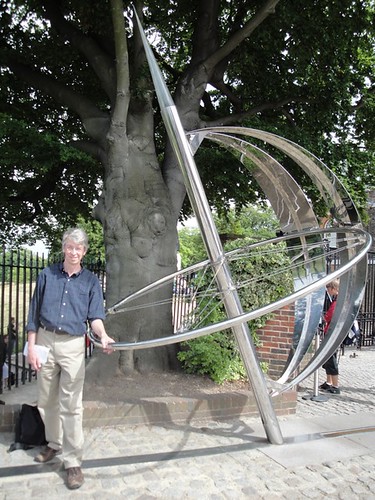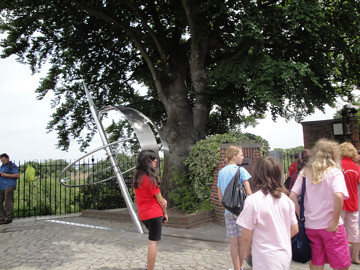Pilgrimage to Greenwich
- By Jim Lochner
- July 31, 2010
- 2 Comments
I’m Jim Lochner, and I lead the education and public outreach effort within the Astrophysics Science Division at NASA/GSFC. Maggie and Sara invited me to write a guest blog as part of the science travel series.
Earlier this summer my wife and I took a vacation to London. One item on my itinerary agenda was taking the pilgrimage to Greenwich, home of the Royal Observatory and the Prime Meridian.
The fun starts just getting to Greenwich. From Westminster Pier (yes, near the famous Abbey, Big Ben, and the Houses of Parliament), you can take a 1-hour boat ride up the Thames river to Greenwich. Along the way, one of the boat’s crew describes the various sites along the river, including London Bridge, the Tower of London, the rebuilt Globe Theatre, etc., along with typical dry, British humor. Our guide had a tendency of pointing out the good pubs.
You end up at the Greenwich Pier. A short distance away is a museum that describes the role of Greenwich is London maritime history. The Cutty Sark, a ship built in the 1860’s, is there to tour, but when we were there it was closed repair and renovation after a recent fire. Also nearby is the Greenwich Market. Small and manageable, unlike the larger markets in London (like Portobello Market and Covent Garden), it has a collection of antiques, jewelry, a dealer with maritime instruments, some tasty foods and snacks, shops, and yes, some assortment of just junk. We enjoyed browsing the various tables. As it got to be around 12:30, I knew it was time to make our way up the hill to the Observatory.
The buildings at the Royal Observatory have been converted into museums. But one historical event still takes place – the raising and dropping of the Time Ball at 1 PM. This dates back to 1833, when ships and timekeepers would set their clocks to Greenwich Time according to the dropping of the ball atop the Observatory. At 12:55 the ball is raised half-way. At 12:58, the ball is raised to the top of the mast and at 1 PM the ball is dropped. Why 1 PM and not noon? Because the astronomers were making the necessary calculations to adjust the Observatory clocks.

The time ball, halfway up (or is it down?) the mast.
We viewed the ball drop in the courtyard where the Prime Meridian lies. I was amused by the fact that there’s a line for the Line (i.e. people line up to have their picture taken straddling the Prime Meridian).
…the line!
The Prime Meridian is defined by the transit instrument designed by the 7th Astronomer Royal, George Airy, in 1850. It’s actually the third Prime Meridian at Greenwich – as the instruments improved, successive Astronomer Royals expanded the building and put their new transit instrument just a bit further eastward. But this is THE LINE, from which all longitude is measured. There’s also an interesting sculpture on the line – I don’t know what it means, but my wife got an interesting shot of it.

The funky sculpture along the Prime Meridian.
When you tour the buildings, you can choose either the Astronomy Route or the Meridian Route. The Astronomy Route goes through the 1890 Physical Observatory building and features information and displays about Astronomy. The Meridian Route goes through the original Observatory building designed by Sir Christopher Wren and Robert Hooke in 1675. This route discusses time and the “Longitude problem”. We took this Route.
The Longitude problem refers to the problem that ships had in the late 1600s for determining their location. Maps of the coast line were getting more accurate, and ships at sea could determine their latitude fairly accurately, but they could not determine their longitude. The result was ships getting lost and some noteworthy shipwrecks. So in 1714 the British government established a prize for anyone who could come up with a reliable way to determine longitude at sea. John Harrison used the approach that if a sea captain could know the time at Greenwich, he could compare that to the time where he was. The difference in the times is related to the longitude. So Harrison set out to make a clock which would keep reliable time at sea. Harrison worked on this from 1726 to 1753, ultimately producing four clocks.
The highlight of the Time Route tour is the room containing Harrison’s four clocks. Three are not like any clock you’ve ever seen, since they had to account for the motion of a ship at sea. Each of the first three were good, but not quite accurate enough. But the fourth looks like an oversized pocket watch, and was good enough to solve the longitude problem. The descriptive label describes it as “probably the most important time piece ever made.” It’s quite remarkable to be able to see firsthand such an important time piece. The rest of the displays show how the mechanisms of the watch were made smaller and more affordable. (Unfortunately they don’t let you take pictures inside the museum, so we don’t have any pictures of these remarkable clocks.)
The museum also describes an astronomical approach taken by Nevil Maskelyne. For this, Maskelyne published the Nautical Almanac in 1766, which is also on display.
Why is all this so personally fascinating? Because as an undergraduate astronomy major at Villanova University, one of our astronomy labs was to determine our latitude and longitude using a theodolite – so I became more familiar than I ever thought I’d be with longitude and the Nautical Almanac. And because Greenwich is so historically significant in western astronomy.
After we got done with our tour, we went back down the hill. In Greenwich you can also visit the National Maritime Museum and The Queen’s House. We ate at Trafalger Tavern, a favorite pub of Charles Dickens. My wife and I relaxed from our day of site seeing over a traditional pub meal of fish and chips.





People don’t realize how important a simple clock was to worldwide oceanic travel. These clocks changed the world dramatically.
Yes Harrison was an amazing person and I am glad you decided to put a visit to Greenwich on your trip. I love antique clocks for this reason. they were made in an era when things were made to a quality and not to a cost. Harrison literally changed the world and is the reason why a large portion of the world speak English !